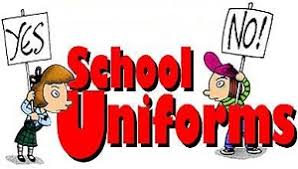School Uniforms- the good, the bad and the ugly
Would you like to wear a uniform to school? Do you think it would be easier? School uniforms date back to the 16th century in the United Kingdom. Universities and primary schools often used uniforms as a marker of class and status. The first public school in the US to require uniforms was Cherry Hill Elementary School in Baltimore, MD. These early uniform programs were voluntary but parents supported the idea. School officials that approved of uniforms in the late 80s saw a shift in students’ minds and saw less discipline issues.
Britannica Pro Con also stated that students were less obsessed with wearing the latest trend because everyone had to look the same. They also eased the financial burden on the less fortunate. On January 3, 1996, President Bill Clinton told Congress, “[I]f it means that teenagers will stop killing each other over designer jackets, then our public schools should be able to require their students to wear school uniforms.” School uniforms set the same standard for everyone.
A study conducted in 2000 found that only 23% of public and private schools require a uniform policy in the United States. The uniform requirement is more common in lower economic areas. Forty-seven percent of low income schools require uniforms, while only about six percent of high social schools require uniforms. It is not a coincidence that low economic areas have adopted the uniform lifestyle. They are usually implemented in low-income schools to prevent the singling out of poor students and reduce bullying.
However, uniforms are also popular at private schools. Private schools generally require uniforms because they want to create a climate that consists of better learning. In the article Admiral Farragut Academy states what the benefits of wearing a uniform are. He claims “there are less opportunities for cliques,” that “students spend less time picking an outfit,” that students gain “self-discipline to wear the uniform properly and respectfully,” that they are “always modest and appropriate for the school environment,” that their is “less peer pressure on how to look,” that “guests or intruders are easily identifiable”, and that “economic or social barriers between students are not evident.” Providing uniforms can be a good way of improving classroom behavior by eliminating distractions and reinforcing that the teacher is in charge. As of now, there are no states that require uniforms so that decision is left in the individual district.
Uniforms have always been a controversial subject in school districts. The main reason why students/parents don’t want to make uniforms required is because they want their kids to be able to express themselves. You learn to be yourself and embrace who you are at a young age and when you are confined to wearing a uniform, you aren’t demonstrating your individuality. Also, paying for school uniforms can be a waste of money, especially if your children attend school for up to 5 or 6 days weekly. Most families who are not financially stable may find it hard to bear the cost of a school uniform. Others find it a more economical option than buying multiple outfits. While some people believe that school uniforms offer many advantages to students, there have been many disadvantages to wearing uniforms as well, which is most likely why school districts have made them optional and no state has mandated their use.
